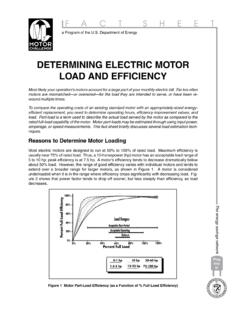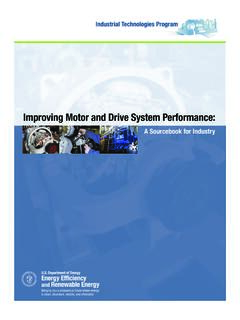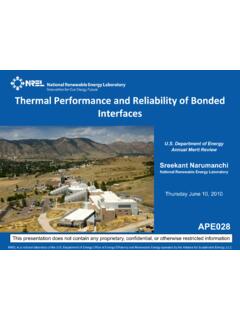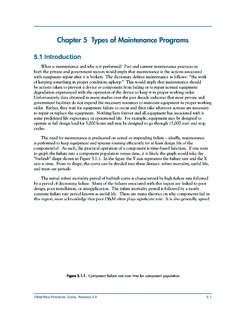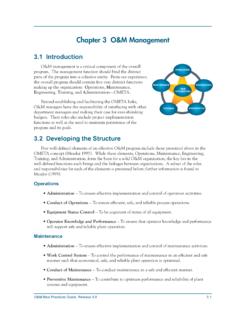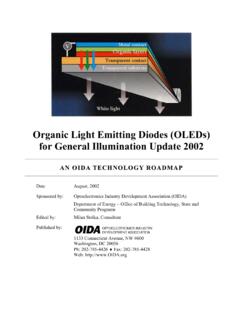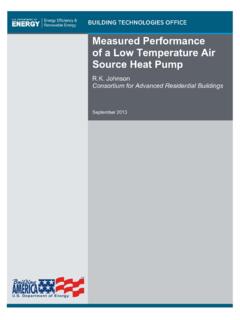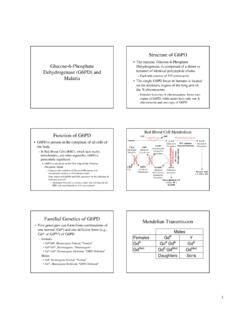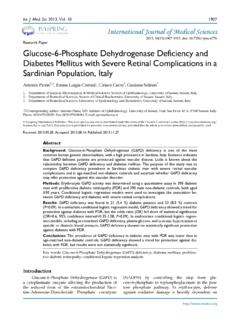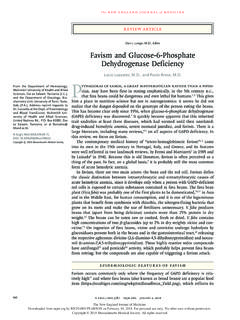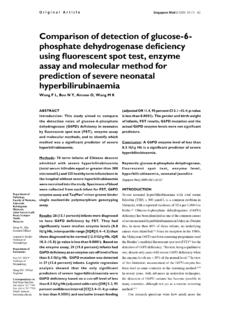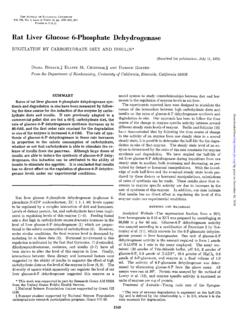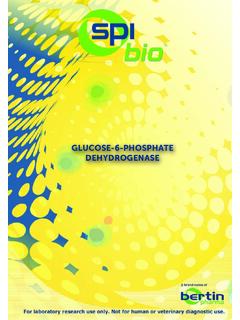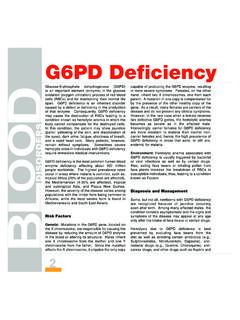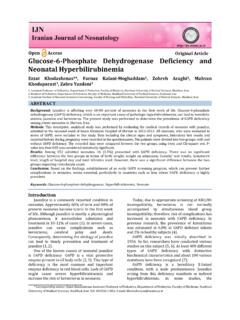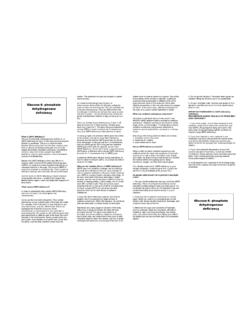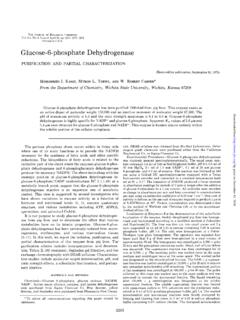Transcription of Efficient Production of Hydrogen from Glucose-6-Phosphate
1 Efficient Production of Hydrogen from glucose -6-PhosphateJonathan Woodward,* Mark Orr, Kimberley Cordray, and Elias Greenbaum Chemical Technology DivisionOak Ridge National Laboratory** Box 2008 Oak Ridge, TN 37831 DOE Hydrogen programAnnual Review MeetingMay 9 11, 2000 San Ramon, California_____To whom correspondence should be addressed* Managed by UT-Battelle, LLC under contract DE-AC0500OR22725with the Department** of EnergyEFFICIENT Production OF Hydrogen FROM glucose -6-PHOSPHATEJ onathan Woodward, Mark Orr, Kimberley Cordray, and Elias GreenbaumChemical Technology DivisionOak Ridge National Box 2008 Oak Ridge, TN 37831 6194 AbstractThe maximum molar yield of Hydrogen that can be obtained from a renewable sugar such as glucoseis 12 mol H per mole glucose .
2 In this work it has been shown that the enzymes of the oxidative2cyclic pentose phosphate pathway coupled to hydrogenase, using NADP as the electron carrier, is+ capable of generating mol H per mole of Glucose-6-Phosphate (G6P). These results provide the2first evidence to indicate that the maximum molar yield of Hydrogen from a renewable sugar, suchas glucose , is possible enzymatically, and, as such, could lead to an efficent process for biohydrogenproduction. IntroductionThe development of alternative sources of energy to oil, is essential as geologists have predicted thatoil shortages will begin in about 10 to 20 years.
3 Even with the discovery of new major oil fields suchas those of the Caspian Basin, oil shortages are still inevitable within a generation (Kerr, 1998).Introduction of a Hydrogen economy into society now seems even more important than a generationago. Biohydrogen Production in vivo and the enzymatic conversion of glucose to H has been2 demonstrated as a method for H Production (Zaborsky, 1998, Woodward et al., 1996, Hershlag et2al. 1998). glucose , a sugar produced by photosynthesis, is renewable, unlike fossil fuels such as of other renewable sugars include xylose, lactose and sucrose (Goyal et al.)
4 , 1991,Woodward, 1984) all of which have the potential to be converted into Hydrogen gas utilizing twoenzymes, glucose dehydrogenase (GDH) and hydrogenase from the extremophiles Thermoplasmaacidophilum and Pyrococcus furiosus respectively (DeLong, 1998, Bonete et al., 1996, Smith et al.,1989, Woodward and Orr, 1998). In this enzymatic pathway for H Production , GDH catalyzes the2oxidation of glucose to gluconic acid (via the lactone) using NADP as the electron acceptor.+NADPH simultaneously reduces hydrogenase and H is evolved.
5 The maximum stoichiometric yield2of Hydrogen possible from glucose by this procedure is only 1 mol per mole sugar which can beachieved (Woodward et al., 1996). However, this value represents only the theoretical postulated that the enzymatic conversion of glucose to H might result in the maximum yield2(~12 mol of H per mole of glucose ) if hydrogenase was included with the enzymes of the oxidative2cyclic pentose phosphate pathway. This was based on results from the pioneering experiments ofHorecker and Racker who showed, respectively, that the oxidation and decarboxylation of 6-phosphogluconate (6PG) resulted in the formation of pentose phosphate and demonstrated the cyclicnature of the complete oxidation of Glucose-6-Phosphate (G6P) to NADPH and CO (Horecker and2 Smyrniotis, 1950, Couri and Racker, 1959).
6 MethodsYeast enzymes of the pentose phosphate pathway were obtained from Sigma Chemical experiments measuring NADPH (NADH) or Hydrogen Production the reaction mixture contained1 manufacturer s unit of G6P dehydrogenase , 6PG dehydrogenase , phosphoribose isomerase, Ru5P-epimerase, transaldolase, transketolase, aldolase, phosphoglucoisomerase, fructose-1,6-bisphosphatase and 50 units of triosephosphoisomerase. Other details are given below. Fructose 1,6diphosphatase was dialyzed against buffer, pH prior to use because the commercial preparationwas shown to contain an inhibitor of the G6P/6PG dehydrogenase couple.
7 Hydrogenase waspurchased from the University of Georgia, Athens. Hydrogen evolution was measured using an in-line Hydrogen sensor with a flow-detection system described in detail previously (Greenbaum, 1984).The reaction mixture for measuring Hydrogen Production by enzymes of the oxidative branch of thepentose phosphate cycle contained 2 Fmol of G6P, 1 unit each of G6P and 6PG dehyrogenases, 63units of Pyrococcus furiosus hydrogenase, and 4 Fmol of NADP in mL 50 mM sodium+ phosphate buffer, pH , at 40EC.
8 The reaction mixture for measuring the enzymatic conversionof G6P to H by enzymes of the oxidative and regenerative branch of the pentose phosphate cycle2 contained 1 Fmol of G6P, each of the enzymes of the pentose phosphate cycle (see ref. 6), 1 Fmolof co-carboxylase, Fmol of NADP , and 63 units of hydrogenase in mL of 200 mM Hepes+buffer, pH , containing 10 mM MgCl at 30EC. The starting pH was measured at ; and after2,92 h of reaction, the pH was of reductant and regeneration of G6P by the oxidative pentose phosphate cycle wasmeasured in a reaction mixture containing mL of M Hepes buffer, pH at 23EC, Fmol of G6P, each of the enzymes of the oxidative pentose phosphate cycle, Fmol ofthiamine pyrophosphate (cocarboxylase), Fmol of NADP , and 100 Fg of the antibiotic+spectomycin.
9 An increase in absorbancy at 340 nm due to the formation of NADPH was monitoredover time. For measuring G6P formation from Ru5P, the reaction mixture (total volume, ml)consisted of ml of hexokinase assay reagent, containing G6P dehydrogenase (Sigma), each ofthe enzymes of the oxidative pentose phosphate cycle except G6P and 6PG dehydrogenases, of cocarboxylase, Fmol of Ru5P, and 100 Fg of spectomycin. The increase in absorbanceat 340 nm due to the formation of NADH by the action of G6P dehydrogenase in the hexokinasereagent was measured at (h)nmol/hORNL DWG 99C-194 Molar Yield of H2 mole/mol G6P2 Molar Yield of mole/mol G6P2 The simultaneous Production of H and CO by the oxidative branch of the oxidative pentose22phosphate cycle was measured in a reaction mixture ( ml)
10 Containing 1 mol G6P, 2 mol EDTA,10 mol MgCl 1 unit each of G6P dehydrogenase and 6PG dehydrogenase , 4 Fmol of NADP , and2,,+63 units of hydrogenase in M Hepes, pH in mL Hepes buffer, pH 7 , at30EC. For further details see Lee et al. (1996).Results and Discussion We conducted experiments to determine whether the oxidative pentose phosphate cycle could beutilized to improve the molar yield of H from glucose by using G6P as the starting substrate. First,2G6P dehydrogenase , 6PG dehydrogenase and hydrogenase were employed to convert G6P toribulose-5- phosphate (Ru5P).


